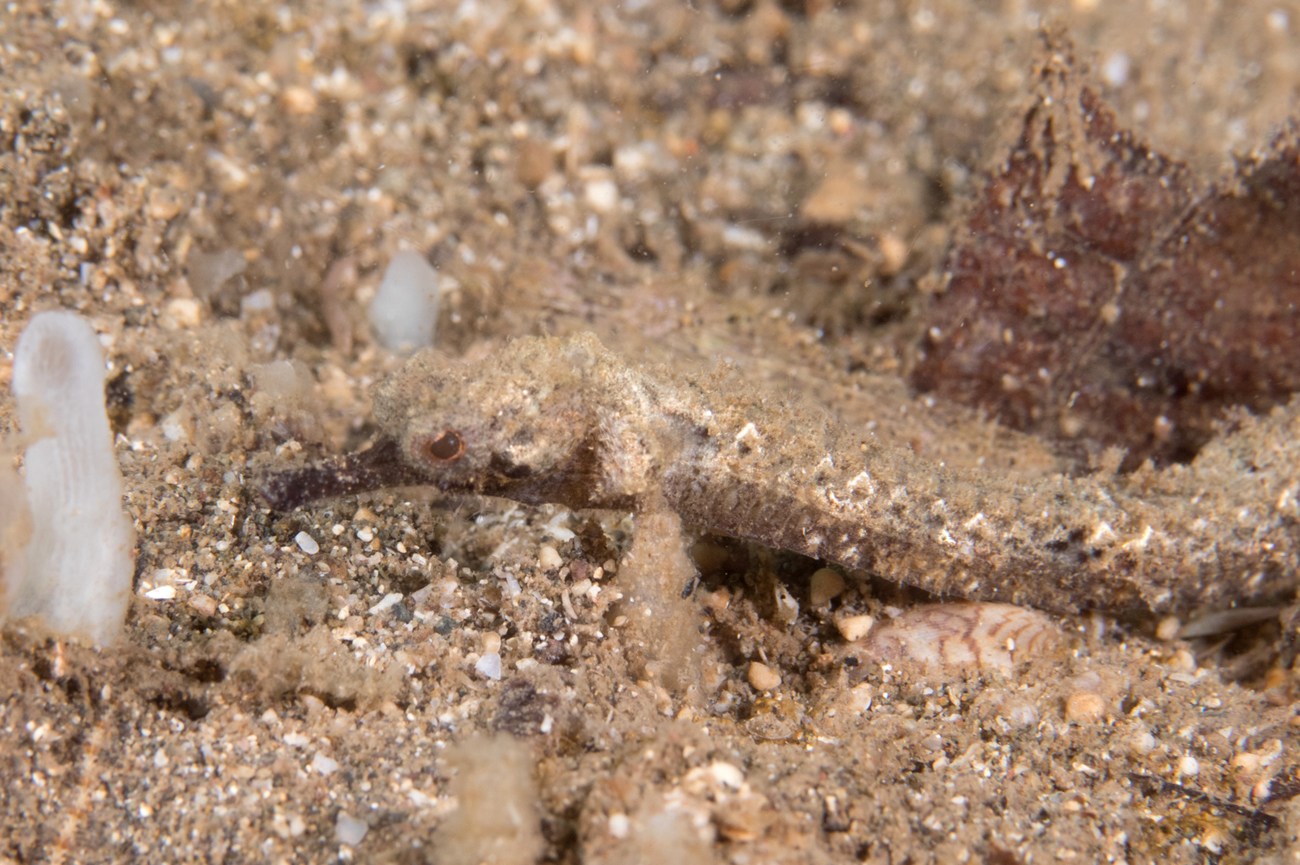Mud Pipefish, Halicampus grayi Kaup 1856

A Mud Pipefish, Halicampus grayi, at Kota Bima, Bima, Nusa Tenggara Barat, Indonesia. Source: Mark Rosenstein / iNaturalist. License: CC by Attribution-NonCommercial-ShareAlike
This tropical species is very well camouflaged in its muddy and silty environments.
Mud Pipefish, Halicampus grayi Kaup 1856
More Info
|
Distribution |
Widespread in the tropical Indo-west Pacific, from the Gulf of Aden across the Indian Ocean to northern Australia, north to Japan; inhabits silty and muddy soft bottoms on the continental shelf from inshore bays to deep offshore areas to 100 m. |
|
Features |
Meristics: D 19-22; A 4; P 15-20; Trunk rings 17-18; Tail rings 32-37. Head and body: Head length 7.7-10.9 in SL; snout short, length 2.0-2.6 in HL; snout depth 3.3-5.3 in snout length; median dorsal snout ridge with small spines and spinules, discontinuous; lateral snout spines present; eye large, dorsal rim of orbit not strongly elevated; principle body ridges distinct, often with a knob-like protrusion on distal third of trunk rings; spiny or irregularly denticulate on distal half of tail. Fins: Pectoral fin base protruding laterally. |
|
Size |
To 150 mm TL |
|
Colour |
Brownish with indications of 12-14 diffuse dark bars on side and dorsum of body; often with diffuse dark blotch on side of 12th-13th trunk ring; opercle and gill membrane usually with pale bars or blotches. |
|
Feeding |
Preys on small crustaceans. |
|
Biology |
Reproduction: Ovoviviparous (gives birth to live young). The eggs are brooded by the males in a semi-exposed pouch under the trunk. The pouch folds fall well short of midline of the egg-filled pouch. Males may begin brooding at 103 mm SL. Eggs: Not described. Larvae: Morphologically similar to adults at birth, however the snout is relatively long in most planktonic young and shorter in demersal juveniles and adults. Planktonic specimens have been collected in the upper 100 m over depths to at least 2980 m. |
|
Fisheries |
None. |
|
Conservation |
Australian Government Legislation: Marine listed under the Environment Protection and Biodiversity Conservation Act 1999. |
|
Remarks |
H. grayi is extremely well camouflaged in muddy or silty habitats. |
|
Etymology |
Halicampus is from the Greek, als, alis for salt and the Greek, kampe meaning bend. |
|
Species Citation |
Halicampus grayi Kaup 1856, Cat. Lophobranchiate Fish: 22, India and Australia (as New Holland). |
|
Author |
Thompson, Vanessa J. & Dianne J. Bray |
Mud Pipefish, Halicampus grayi Kaup 1856
References
Allen, G.R. & M. Adrim. 2003. Coral reef fishes of Indonesia. Zool. Stud. 42(1): 1-72.
Dawson, C.E. 1985. Indo-Pacific Pipefishes (Red Sea to the Americas). Gulf Coast Research Laboratory, Ocean Springs, Mississippi. 230 pp.
Hoese, D.F., D.J. Bray, J.R. Paxton & G.R. Allen. 2006. Fishes. In Beesley, P.L. & A. Wells (eds). Zoological catalogue of Australia. Volume 35. ABRS & CSIRO Publishing: Australia. 2178 pp.
Jeyaseelan, M.J.P. 1998. Manual of fish eggs and larvae from Asian mangrove waters. United Nations Educational, Scientific and Cultural Organization. Paris. 193 pp.
Kaup, J.J. 1856. Catalogue of lophobranchiate fish in the collection of the British Museum. London. Cat. Lophobranchiate Fish.: 76 pp, Pls. 1-4.
Kuiter, R.H. 2000. Seahorses, Pipefishes and their Relatives. TMC Publishing, Chorleywood, UK. 240 pp.
Kuiter, R.H. & T. Tonozuka. 2001. Pictorial guide to Indonesian reef fishes. Part 1. Eels- Snappers, Muraenidae - Lutjanidae. Zoonetics, Australia. 302 pp.
Nakabo, T. 2002. (ed.) Fishes of Japan with pictorial keys to the species. English edition. Tokai University Press. vol. 1, 866 pp.
Paulus, T. 1999. Family Syngnathidae. pp 2264-2276, In Capenter K.E. & Niem V.H. (eds) The Living Marine Resources of the Western Central Pacific. FAO Species Identification Guide For Fisheries Purposes. FAO Vol. 4. pp 2069-2790.
Pogonoski, J.J., D.A. Pollard & J.R. Paxton. 2002. Conservation Overview and Action Plan for Australian Threatened and Potentially Threatened Marine and Estuarine Fishes, Environment Australia, Canberra. 375 pp.
Randall, J.E., Allen, G.R. & R.C. Steene. 1997. Fishes of the Great Barrier Reef and Coral Sea. Crawford House Press. Bathurst. 557 pp.



